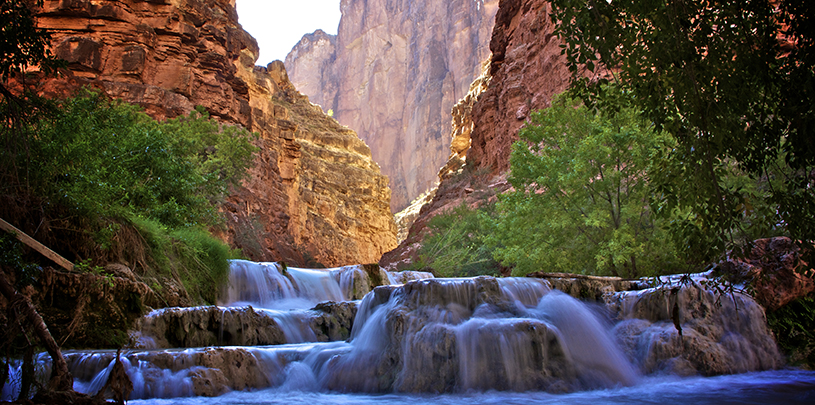
 by Roger Clark, Grand Canyon Director
by Roger Clark, Grand Canyon Director
The Grand Canyon is dry — you can see it in the parched landscape, feel it in your cracked skin. And it’s getting drier. Climate change, scientists say, will reduce groundwater recharge in the Grand Canyon region.
A new study published in Nature in November 2020 analyzes historical data, makes climate projections, and predicts groundwater infiltration. It concludes that warming temperatures and drought point toward less water soaking into the ground to replenish aquifers below. This new analysis casts more doubt on the guzzling mega-resort developers want to build on the doorstep of Grand Canyon National Park.
For decades, the Italian company Stilo Development Group has been pushing to build thousands of housing units, hotel rooms, an RV park, a conference center, and commercial space in the town of Tusayan, which sits two miles from the entrance to Grand Canyon National Park. Tusayan is entirely dependent on groundwater for its water needs. So too, the study says, is Grand Canyon National Park and its 6 million annual visitors, the Havasupai Tribe, Hualapai Nation, and the neighboring Grand Canyon communities of Williams and Jacob Lake.
The proposed Tusayan development would tap into an already over-tapped water supply, adding thousands of new residential toilets, sinks, and faucets. Wells in Tusayan, upon which the new housing would rely, siphon water from the Redwall-Muav aquifer, which sits more than 3,000 feet beneath the surface. This aquifer is the primary source for the seeps, springs, and streams on the Grand Canyon’s south rim.
Researchers in the study predicted that climate change will diminish the aquifer’s natural recharge over time. Inevitably, this will lead to dwindling Grand Canyon waters and reduced flows of Havasu Creek, the lifeblood of the Havasupai homeland.
Before Stilo can break ground, it needs permission from the Kaibab National Forest to pave roads and run utilities across public land to its two parcels of private land that are surrounded by national forest. In September 2020, the Forest Service preliminarily accepted Stilo’s proposal. Before the agency makes a final decision, it must first conduct an in-depth environmental impact assessment — a process that allows for public comment. Additionally, Stilo must provide the Forest Service with missing information about plans for supplying water and handling sewage.
Depleting already diminishing supplies of groundwater is one of the most potentially devastating impacts of the proposed Tusayan development. The Forest Service rejected an earlier version of Stilo’s proposal in 2016, citing the depletion of the Grand Canyon’s groundwater, loss of wildlife habitat and public land for recreation, and increased traffic congestion, among other concerns. The agency concluded that the proposed mega-resort was “not in the public interest” as it would “stress local and Park infrastructure, and have untold impacts to the surrounding Tribal and National Park lands.”
Five years later, what’s different? Stilo’s plans still include pumping groundwater from the Grand Canyon’s underground reservoir — a source that, as the climate change study and previous research suggests, is shriveling. In the coming years, and decades, the Grand Canyon region will have less available water for its communities, plants, and animals. Not more. If there is a reason to protect the inherent preciousness of water for all those living in the desert, climate change is it.
If the Forest Service moves Stilo’s most recent proposal forward in the coming months, then the agency will open a public comment. We’ll again call on you to speak up for the Grand Canyon’s precious waters, and together, with Grand Canyon advocates across the country, we’ll work to keep the canyon grand.
Take Action. Urge the U.S. Forest Service to deny road and utility easements for the development and require a full environmental review.
The Colorado River below Glen Canyon Dam is heating up. Find out why.
Read MoreGroundwater pumping at a uranium mine near the Grand Canyon will affect the canyon's springs, scientists says.
Read MoreArizona Governor Katie Hobbs is the latest elected official to call for an environmental review of Pinyon Plain uranium mine.
Read More